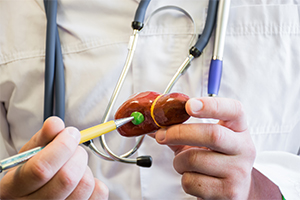
You’ve heard of the appendix, the organ in our bodies that resides in the lower right abdomen, and seems to serve no real purpose in the body. You’ve heard that even though this organ exists and functions within us, you can live normally without it, and if it bursts—you’re in for emergency surgery to remove it. Similar things can be said about the gallbladder—you can live without it, for example—but the gallbladder has a proven function, and its misfiring can lead to serious and long-term health complications.
What is a gallbladder?
The gallbladder is an organ located in the upper right quadrant of the abdomen, just below the ribcage. It is nestled underneath the liver and is connected to the liver by a duct.
What does a gallbladder do?
Normally shaped like a pear, the gallbladder (unlike the appendix) has many functions. The gallbladder is part of the biliary system, which aids in digesting the food you eat. It stores bile, the liquid produced by the liver to help break down fats that you eat.
Bile is made up of water and bile salts, which help break down large globs of fat in fatty meals—as well as some cholesterol. It can hold between one to three ounces of bile at a time.
As your stomach digests food, the gallbladder releases bile into your small intestine, ready to help break down the fat in the meal. Bile is produced in the liver and transported into the gallbladder; where it is stored until it’s time to dump into the small intestine.
Why do I have pain in my gallbladder?
By far, the most common cause of pain in the gallbladder is gallstones. But there are a few more reasons why you could be experiencing pain in the gallbladder:
• Biliary sludge. Bile is made up of water and bile salts, which help break down fat in the body. Sometime this mixture is too thick and clogs up the exit of the gallbladder, preventing healthy bile from leaving the gallbladder and entering the intestines.
• Inflammation of the gallbladder. Also called cholecystitis, inflammation of the gallbladder can lead to pain and other symptoms like nausea, vomiting and fever.
• Infection of the bile duct. Also called cholangitis, an infection in the common bile duct often caused by gallstones. The gallstones may obstruct healthy bile from leaving the gallbladder, causing an infection.
• Gallbladder rupture. If this inflammation is too severe, the gallbladder may rupture suddenly, much like the appendix. The gallbladder may also rupture due to a traumatic event, like a vehicle accident. This is very rare and would cause a different type of pain than patients may be used to.
• Biliary dyskinesia. This is a syndrome that occurs when the muscular valve that controls the follow of bile in and out of the gallbladder is now working properly. The bile does not drain properly and may cause nausea and vomiting.
• Gallbladder disease is referred to as chronic acalculous gallbladder dysfunction. It’s the name for gallbladder disease when gallstones are not present.
• Gallbladder cancer is extremely rare and often not diagnosed until it has progressed for some time. Besides pain, a person with gallbladder cancer may be jaundiced and experience nausea.
How do I know if I have gallstones?
An estimated 20 million Americans may have gallstones, the most common type of gallbladder disorder. Gallstones are formed in the gallbladder when the bile inside has a higher concentration of cholesterol and bilirubin, causing calcification into hard, small stones inside the gallbladder. They can range in size from a few centimeters to the size of a golf ball.
Gallstones are the most common reason for gallbladder pain as the formation of the gallstones happens very slowly over a period of time. It’s actually possible to have gallstones and have no symptoms. Pain occurs when a gallstone blocks one of the ducts in the biliary tract, interfering with the gallbladder’s main function.
Signs that your gallbladder may be clogged by a gallstone can mimic other conditions and change if the stone shifts away from the duct, so it’s important to pay attention to how you feel after you eat certain foods. Symptoms include severe and sudden pain underneath the right ribcage, shoulder blade or shoulder after eating, vomiting and nausea.
When do I get it removed?
The most common treatment for gallbladder pain is removal of the gallbladder itself. Because the liver is the source of the bile and can also store it as needed and release into the intestines, living without a gallbladder is a possibility. The bile simply bypasses the gallbladder completely and gets transferred to the intestines from the liver.
Consulting with a physician is the best way to determine whether or not your gallbladder needs to be removed. Usually a physician will recommend removal if gallstones are interfering with your body’s ability to digest food normally, or causing a significant amount of pain.
Gallbladder removal surgery is usually an outpatient procedure and can be done laparoscopically or in an open surgery.
How do I avoid gallstones?
Preventing gallstones is certainly possible. There are several things you can do to keep your gallbladder—and body—healthy:
• Exercise daily
• Eat a balanced diet rich in vegetables, fruits, whole grains, legumes and spices
• Avoid foods with high saturated fat and cholesterol
• Visit your primary care physician for regular check ups
• If you have gallbladder pain, be sure to get checked out by a doctor.
Because gallstones develop so slowly, you may be able to reduce the number of or reduce the growth of several gallstones, keeping your gallbladder functioning normally. Unlike your appendix, a gallbladder has many uses. While you can live normally without it, it’s always best to keep prevention in mind when determining lifestyle choices.









Most Commented